|
Visit of Oslo
|
Overall Schedule
Times in italics:
Approximates
|
|
Details
| Lunch
and Dinner at Café Europa |
Café Europa,
St. Olavs gate 31, 0166 Oslo , Tel +47 22 20 18 95
 |
|
Vigelandsparken |
Gustav Vigeland's Sculpture park. Famous Park in
Oslo.
Free time visit (access is free of
charge)
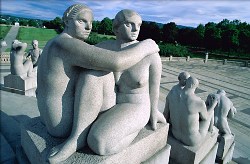 Vigeland Park has an interesting history. In 1901 Gustav
Vigeland made a fountain for Oslo, which was so popular with the
town that it was purchased in 1904. They just had one
problem…they couldn’t decide where to display it. It was put
into storage until 1921, when the city made him an offer he
couldn’t refuse. They would give him a home and studio for life
if everything he produced was for the city. Vigeland Park has an interesting history. In 1901 Gustav
Vigeland made a fountain for Oslo, which was so popular with the
town that it was purchased in 1904. They just had one
problem…they couldn’t decide where to display it. It was put
into storage until 1921, when the city made him an offer he
couldn’t refuse. They would give him a home and studio for life
if everything he produced was for the city.
In the park, Vigeland used 3 different materials. All the
gates are made of wrought iron, the figures in the central area
are bronze, and those in the far end are carved from granite.
Highlight of the park is the Monolith, a 52 feet sculptured
granite pillar, which is all one piece of granite. The park’s
sculptures represent Man’s progress from the cradle to the
grave. It is a work of Stone and Bronze art from the beginning
to the end of the park.
|
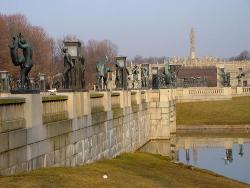 First you encounter the bridge that has works of art from
birth to death. You then arrive at the gardens and the
fountains. The fountains are trees of life and are quite
spectacular. Next up will be the Monolith, with it carvings of
human limbs and finally you come to the Ring of Life at the end
of the park. First you encounter the bridge that has works of art from
birth to death. You then arrive at the gardens and the
fountains. The fountains are trees of life and are quite
spectacular. Next up will be the Monolith, with it carvings of
human limbs and finally you come to the Ring of Life at the end
of the park. |
|
Vikingship museum |
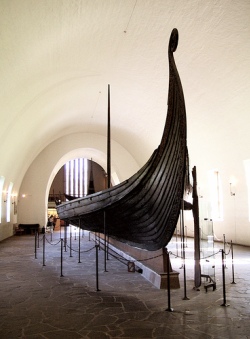 The
Viking Ship Museum displays the large Viking ships Oseberg,
Gokstad and Tune, as well as founds from the chief grave at
Borre in the Vestfold district. The
Viking Ship Museum displays the large Viking ships Oseberg,
Gokstad and Tune, as well as founds from the chief grave at
Borre in the Vestfold district.
The three ships are the best preserved Viking ships known, found
in royal burial mounds in the Oslo fjord. As burial ships,
carrying the dead over to “the Other World”, the ships were
equipped with unique treasures such as wagons, horses and
especially textiles which are seldom preserved from the Viking
age, now on exhibit
The
three ships are the best preserved Viking ships known, found in
royal burial mounds in the Oslo fjord. As burial ships, carrying
the dead over to “the Other World”, the ships were equipped with
unique treasures such as wagons, horses and especially textiles
which are seldom preserved from the Viking age, now on exhibit
at the museum. |
| Holmenkollen
|
Area on top of Oslo hill with the famous Ski Jump
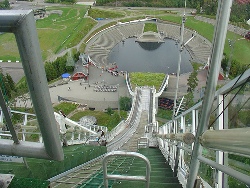 Participants may go up to the top of the Ski Jump. This will
cost 60NOK per person.
Participants may go up to the top of the Ski Jump. This will
cost 60NOK per person.
Interested People should inform the organizers at lunch time
at the latest, so that the guides are informed and a time
slot is reserved appropriately.
|
|
Stop next to National Gallery |
Free time in Olso. Participants will be dropped next to the
National Gallery that they can visit (free-of-charge access) -
Closes at 17:00
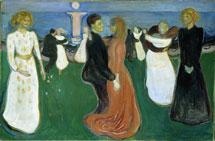 The National Gallery has Norway's largest
collection of Norwegian, Nordic and international art from the
beginning of the 19th century up until today. The main
exhibition displays Norwegian and international paintings and
sculptures from the 19th century up until today, including many
of Edvard Munch's major works. The National Gallery has Norway's largest
collection of Norwegian, Nordic and international art from the
beginning of the 19th century up until today. The main
exhibition displays Norwegian and international paintings and
sculptures from the 19th century up until today, including many
of Edvard Munch's major works.
|
|
|